Lifestyle
Eurovision 2024: Here are the songs with the best shot at glory

Switzerland’s Nemo rehearses “The Code” before the second semifinal.
Jessica Gow/TT News Agency/AFP via Getty
hide caption
toggle caption
Jessica Gow/TT News Agency/AFP via Getty

Switzerland’s Nemo rehearses “The Code” before the second semifinal.
Jessica Gow/TT News Agency/AFP via Getty
Year after year, the Eurovision Song Contest delivers a dazzling, glittery spectacle of only barely contained chaos. There’s all the lights, fireworks, flags, sequins, disco balls and dance breaks, of course – but there’s also the songs themselves, which this year boast displays of (vocal) gymnastics more impressive than anything you’ll see flipping across a mat in Paris this summer.
Know this: 2024’s brace of 26 Eurovision finalists represent what is, even for this contest, a maximalist bunch. These songs go big. I’d go so far as to say that the broadcast on Saturday (starting at 3:00 p.m. ET on Peacock) is shaping up to qualify as Peak Eurovision, so prepare to bask in the glorious bombast of it all.
Musically, expect the usual mix of pop bops, baroque ballads and club bangers. Also, as always, stirring anthems about (pick one or more) standing up or holding up or looking up or not giving up. But in terms of vibe? This year’s roster teems with performers positioning themselves as quirky/witchy iconoclasts. You know the sort: bold, irrepressible individuals who reject the (checks notes) conformist RULES of (checks notes again) SOCIETY.

The welcome presence of such gleefully bonkers acts as Ireland’s Bambie Thug, Finland’s Windows95man, San Marino’s MEGARA, Slovenia’s Raiven and many others – including several performers highlighted below – makes it official: Eurovision 2024 is The Year of the Weirdo.
For those of us who’ve had to suffer through the past few years of the contest, which were overstuffed with wan, weepy young men warbling about heartbreak, I say: Bring it on, ya joyous freaks.
And, though Eurovision organizers see the event as “non-political,” it has been, as in the past, a televised concert with synth beats, glitter on the floor, and geopolitical undertones. Earlier this year, artists from Finland and Iceland called for Israel to be banned from the competition outright for its military offensive in Gaza. Israel was asked to revise the lyrics to their entry in the competition this year, when an initial song seemed to refer to Oct. 7 attacks by Hamas. Anti-war protests are planned outside the Malmo Arena on Saturday.
Here’s what you need to know before Saturday’s Grand Final.
The rules

Finland’s Teemu Keisteri, also known as Windows95man, emerges from a denim egg while performing the song “No Rules!” during the first Eurovision semifinal in Malmo, Sweden, on Tuesday, May 7.
Jessica Gow/TT News Agency/AFP via Getty
hide caption
toggle caption
Jessica Gow/TT News Agency/AFP via Getty

Finland’s Teemu Keisteri, also known as Windows95man, emerges from a denim egg while performing the song “No Rules!” during the first Eurovision semifinal in Malmo, Sweden, on Tuesday, May 7.
Jessica Gow/TT News Agency/AFP via Getty
We won’t be diving deep into the internecine details of Eurovision voting, because they’ll spend a lot of time during Saturday’s broadcast explaining everything in punishing detail (which is historically a good time to refresh your drink and/or nip to the bathroom).
But, very basically: The 37 countries participating in Eurovision this year each submitted a song to compete in two semi-finals which took place earlier this week. Of those 37, 26 are competing in Saturday’s Grand Final. Six sailed through easily: every year, the so-called “Big Five” countries – France, Spain, Germany, Italy and the U.K. – automatically qualify for the Grand Final, as they contribute the most money to the competition. Also guaranteed to advance: Whichever country won the previous year’s contest, thereby hosting the competition this year. In this case: Sweden.
This year, the 20 other countries that made it to the Grand Final were entirely determined by viewers watching at home, the so-called televote. This put an interesting spin on things, because in the past, placement in the Grand Final was determined by a 50/50 combination of the televote and the votes of an international jury of music industry professionals.
Doing away with the jury vote in the semifinals meant that performers who brought a lot of crowd-pleasing visual flair to their qualifying performances had a better shot than in years past. The international juries will be back for the Grand Final, however. How their historically conservative, wet-blanket sensibilities mesh with the voting public’s love of shiny glittery fiery extravagance is a big part of what makes Eurovision so damn compelling and unpredictable.
So, during Saturday’s Grand Final, 26 countries will perform – the 20 qualifying countries, the Big Five, and the host nation, Sweden. Each performance must adhere to the following rules:
- Songs must be original.
- Songs must be no more than three minutes in length.
- Lead vocals must be performed live.
- No live instrumentation of any kind is permitted.
- During a song, no more than six performers may be onstage at the same time.
Just to underscore Rule 3: Eurovision is not and has never been a lip-syncing competition. These performers are singing live, though their instrumentation and backing vocals are pre-recorded. If on Saturday you find yourself beginning to doubt that fact, particularly for countries whose performers incorporate propulsively aerobic choreography like Georgia, Cyprus and Austria, remind yourself that you’re not watching a lip-sync, you’re watching tremendous breath control.
The live vocal performance is all-important. Over the years, more than a few acts have sailed into the Grand Final favored to win, only to have a hesitant, breathless or off-key vocal in the live performance destroy their chances. Stakes. Gotta love ’em!
And as for Rule 4: Whenever a performance involves a “band” wailing away on their drums, guitars and/or saxophones, remind yourself you’re not watching them actually shred, you’re watching them mime. It’s kind of cute.

Ireland’s Bambie Thug performs “Doomsday Blue” during the first semifinal.
Jessica Gow/TT News Agency/AFP via Getty
hide caption
toggle caption
Jessica Gow/TT News Agency/AFP via Getty

Ireland’s Bambie Thug performs “Doomsday Blue” during the first semifinal.
Jessica Gow/TT News Agency/AFP via Getty
The Grand Final
Last year, for the first time, viewers in the U.S. were able to vote for their favorite Eurovision performances – though those votes got pooled with other non-participating countries around the world. This year the U.S. will again have a chance to vote in the Grand Final via the Eurovision app.
Here’s how Saturday’s Grand Final will proceed. First, the 26 countries will perform their songs. Then the audience will vote. (NOTE: Viewers in participating countries cannot vote for their own country, which at least notionally prevents the big population centers from dominating the contest.) The audience vote will be tallied. Then the jury votes will be collected over a series of glorified Zoom calls to representatives in each participating country, which will be marked by video lags and audio dropouts; this process is awkward, interminable, cringeworthy and delightful. The jury votes will be tallied, which may or may not completely supersede the televote. The winner will be announced, a trophy will be handed out, and the winner will perform the winning song again. The end.
Here are the songs with the best shot to win this year’s Eurovision Song Contest, as determined by me, a middle-aged queer American man who loves bops and hates ballads. Which is to say: This is a highly subjective list. If you want to know what the oddsmakers think, go here.
Netherlands: “Europapa” by Joost Klein
Eurovision
YouTube
This goofy, peppy, earwormy bop is classic Eurovision – and that’s even before you factor in its lyrics, which are essentially a love song to the European Union itself. Specifically, to the ability to galavant around the continent freely, cheaply and without a care in the world. (At the end, he also sneaks in a tribute to his late father, “Who told me once the world has no borders.”) Basically, this song represents the catchiest, sunniest possible way to say: Eat it, Brexiters!
Estonia: “(nendest) narkootikumidest ei tea me (kull) midagi” by 5MIINUST & Puuluup
Eurovision
YouTube
Sure it’s a bunch of burly, beardy dudes dancing a TikTok-ready folk dance, playing folk instruments and, yes, throat-singing. In other words: Eurovision Bingo! But it’s so much more than that: These performers radiate undeniable bear-daddy charisma, and the driving uptempo beat, paired with that plaintive, soaring vocal (“Oooooooooh, yea-eahhhhhhhhh”) will crawl inside your medulla oblongata and set up housekeeping. The title translates to “We (really) don’t know anything about (these) drugs,” and the Estonian lyrics read like a suspect pleading his innocence on a drug arrest: “I don’t know drugs, I know soda and cider/Couldn’t tell the difference between vitamins and speed.” “We avoid intoxicating substances, that’s something rich people do.” Uh-huh. Suuuuure.
Croatia: “Rim Tim Tagi Dim” by Baby Lasagna
YouTube
In many ways, “Rim Tim Tagi Dim” offers a sardonic counterpoint to the Netherlands’ “Europapa.” Where that song celebrates the freedom of travel within the EU, this one laments the loss of opportunity in Eastern Europe which is causing thousands of young people to leave their homes and migrate to the West. Granted, performer Baby Lasagna puts a wink on it all (“Bye mom, bye dad/Meow, cat, please meow back”), all set to an insistent, Rammsteinian marching rhythm. But he finds a way to lean into the melancholy at the same time (“There’s no going back/My presence fades to black.”) It’s that kind of narrative turducken – and, let’s be real, a killer hook – that make this at least a Top Three contender, if not the outright winner. Croatia has never won Eurovision, so that would be a big deal.
Italy: “La Noia” by Angelina Mango
Eurovision
YouTube
“La Noia” means “The boredom,” and Angelina Mango saturates her vocals with a fitting amount of over-it-all ennui even as the syncopated, percussive melody swirls and throbs and compels you out of your seat and onto the dance floor. (In this case, the dance floor is your living room.) Lyrically, the song’s about a woman who turns to dancing and partying to deal with “these wasted days.” “A crown of thorns will be the dress code for my party,” she sings, which is a deeply Italian but weirdly emo sentiment for a song so doggedly determined to set your booty shaking. Mango’s got a huge following because she’s a mesmerizing performer who never breaks a sweat, even during those passages when the tempo suddenly accelerates and the lyrics start speeding by so fast they threaten to turn the song into a five-Vespa pile-up. Keep an eye on her.
France: “Mon Amour” by Slimane
Eurovision
YouTube
Slimane invests this straight-down-the-middle ballad with a searching, plaintive, torch-song quality that’s more quintessentially French than a beret slathered with Camembert and stuffed in a baguette. If you go by the lyrics, the guy’s kind of a pill: Urging his lover to return to Paris, promising things will be different, demanding to know if they love him, and at one point asking the most hilariously red-flaggiest of all questions, “What do we do about my pain?” But Slimane emotes all over the stage, and his insinuating vocals slide you right past the ick of it all. He’s not a flashy performer, so the televoters might not pick up what he’s putting down, but the jury is sure to give the technical skill on display here the love it deserves.
Ireland: “Doomsday Blue” by Bambie Thug
Eurovision
YouTube
“Doomsday Blue” is an example of my favorite Eurovision phenomenon – the underdog glow-up. When Bambie Thug’s queer, witchy mix of metal and melody won them the right to compete for Ireland, there were plenty of rolled eyes, clucked tongues and shrugged shoulders. “Too weird,” they said. “Too dark,” they said. But somewhere on their way to Sweden they upped their game and have arrived at an even weirder and darker stage performance that’s, well, spellbinding. The spell in question is a hex, to be sure – the singer deftly switches between summoning black magic to torment an ex-lover (“Avada Kedavra/I speak to destroy”) and murmuring a light, sweet tune of resignation and acceptance (“I guess you’d rather have a star than the moon/I guess I always underestimate you”). Bambie Thug’s performance in the first semifinal electrified the crowd, and it tells a story: They dance with a demon and, in so doing, gain the ability to subdue it, and defeat it. I predict the voters at home will eat this all the way up, while the jury voters will find themselves some pearls to clutch.
Spain: “ZORRA” by Nebulossa
Eurovision
YouTube
Strictly speaking, zorra means a female fox, but as commonly deployed, it’s a coarse term for a, um, free-spirited woman, or at least a woman you don’t like. You know how Old Hollywood movies used to bust out the word “vixen” – a female fox – to describe the kind of woman played by Joan Crawford and Bette Davis? It’s like that, only ruder. In this song, Nebulossa does solid work not only reclaiming the word, but luxuriating in it. Translated from the Spanish: “I know I’m not who you want me to be (zorra, zorra) /I get it, it’s driving you up the wall (zorra, zorra)/But this is just my nature (zorra, zorra)/Can’t be bothered to change for you.” Preach. In the run-up to semi-finals her vocals have proven, to put it kindly, a bit uneven, so this could go either way. The caked-up male backup dancers in thigh boots, butt-floss thongs and corsets should help smooth things over. (Confession: This song doesn’t have much of a path to winning; I just like it, and the aforementioned dancers, a tremendous lot.)
Ukraine: “Teresa & Maria” by alyona alyona and Jerry Heil
Eurovision
YouTube
Pop singer Jerry Heil and rapper alyona alyona come together for this song that urges faith and perseverance by invoking both Mother Theresa and the Virgin Mary. The risk when blending two such discrete musical approaches is that each will lose its singular character once combined, but that’s not the case here. The two performers remain distinct, and they create a kind of two-sided musical conversation – a song that comments on itself. Ukraine always comes into the competition with a certain amount of international goodwill, but they also consistently stage their entries in ways that make indelible visual impressions on the home audience. Don’t underestimate Ukraine, in Eurovision and in life.
Austria: “We Will Rave” by Kaleen
Eurovision
YouTube
Several countries submitted club bangers with extended dance breaks this year. (See also: Georgia, Cyprus, Luxembourg, Malta.) But Austria’s “We Will Rave” is the best of the sweaty, sexy bunch, in no small part because it’s not content to serve you up just a dance break. You’re not even through the first verse before the song outfits you with its own remix. No more long weeks waiting around for some DJ on Ibiza to do that heavy lifting for you – the club mix is already here, factory installed for your convenience! Also: a fake-out ending followed by a breakbeat finish? Are you kidding? Yes, it’s dated – it’s giving “Night at the Roxbury” – but it’s also, not for nothing, catchy as hell. Why this song has a shot: Kaleen’s a known and beloved Eurovision presence – a dazzling dancer who’s fully capable of turning it all the way out in the live performance. Why that shot will probably go awry: Even if the home viewers eat this up, Eurovision’s international juries have not been kind to dance music, as they are made up of music industry snobs – the very fuddiest of duddies – who wouldn’t know a stone cold groove if it bit them squarely on their stone cold groove things.
Switzerland: “The Code” by Nemo
Eurovision
YouTube
Eurovision oddsmakers (yes, that’s a thing) say this song is one of the clear favorites to win the contest this year, which makes sense, as it’s the perfect distillation of ESC 2024’s whole heedlessly maximalist vibe. It’s got a bit of opera, a bit of (light!) rap, some drum-and-bass EDM – it’s, you know, a lot. Toss in the lyrics about performer Nemo realizing their non-binary status (“Somewhere between the 0’s and 1’s/That’s where I found my kingdom come”) and it’s gonna be tough to beat. Any song crammed with this many different styles can come off like something assembled in a lab, but Nemo brings us along with them, fluidly and effortlessly sailing through each transition. If they can pull it off live, this one’s got all the earmarks of a showstopper – and a winner.

Lifestyle
Why you should think twice before posting that cute photo of your kid online


Many parents share photos and videos of children on social media: birth announcements, their kid making a mess at the dinner table, their milestones like a first step.
But there are potential dangers to constantly posting about your child online, says Leah Plunkett, a faculty member at Harvard Law School who specializes in children, family law and technology. In Plunkett’s 2019 book Sharenthood: Why We Should Think Before We Talk About Our Kids Online, she explains how adults can put children’s privacy and personal data at risk.

This phenomenon is called “sharenting,” says Plunkett. Legal scholars in her field use the term — a portmanteau of “sharing” and “parenting” — to describe “all the ways that parents, aunts, uncles, teachers, coaches and other trusted adults in a kiddo’s life transmit children’s private information digitally.” It can make kids vulnerable to identity theft and harassment. And as they grow older, it may undercut their ability to tell their own story.
Plunkett talks to Life Kit about the different harms of oversharing, how to post information about your kid safely and how to talk to loved ones about your limits. This interview has been edited for length and clarity.
Parents share a surprising amount of data about their kids online. A birthday photo, for example, can reveal a kid’s name, age and date of birth. What are some of the privacy concerns around that?
There is a thriving black market for personally identifiable information. Kids’ Social Security numbers, when combined with date of birth, name and address, are often good targets for identity theft. Most minors don’t have credit attached to their Social Security numbers, so [someone may be able to use them to] open fraudulent lines of credit.
Creditors don’t verify the age of applicants, so a bad actor could potentially open a credit card without anyone noticing until the kid becomes an adult and wants a card of their own. What are some other security risks?
There are tragic cases of stalking, bullying and harassment. They are rare but they do happen.

So someone could use social media to figure out where your kid lives, goes to school and their patterns and routines. They could also learn about their likes and dislikes and use them in an insidious way.
Other people don’t need to have information about the ins and outs of your child’s emotional and personal life.

You write in your book that children’s data is a form of currency. And there’s the adage that if a product is free, you are the product. What should adults think about when giving a company their child’s data? Or when reading the fine print on a social media platform?
Parents should be aware that they’re not going to know at the moment where a piece of information, photo or video, might go. When we click “I accept,” those agreements give companies and third parties a lot of latitude about what they can do with your data.
After my book came out, The New York Times ran a big investigative piece about the ways in which social media photos of toddlers and young children had been surreptitiously used to train facial recognition software. That’s one of many examples.

Also, at some point down the road, maybe somebody makes a decision about your child based on the stuff you’ve put out about them — how your child is doing at school, how they’re moving through the world. Maybe that is an individual human decision maker. Maybe that is an algorithmically driven data analysis product.
And when you mean decision makers, that could be a university recruiter or a hiring manager. And that may affect your child’s ability to tell their own story.
To themselves or to others in the future. If the world is figuring out significant things about who they are online and making projections about who they’re going to be, it can undercut their ability to figure that out for themselves.
Reading your book, it’s clear you’re not like a Luddite. You have kids, but you haven’t sworn off social media. How do you avoid oversharing the digital realm?
Since I started researching this topic, I adjusted my own personal compass to be very minimalist. I pretty much never post my kids on social media. If I do, you don’t see their faces or anything that would identify them. I don’t use full names. I don’t celebrate their birthday on social media. I don’t show the kids standing in front of where they go to school.
I follow a “holiday card-or-less” rule of thumb when sharing on social media: updates you’d be comfortable with anyone, from your great aunt to your boss, seeing. Information that’s not going to embarrass anybody and isn’t particularly private.
Personally, my wife and I are pretty tight about the pictures we share of our kid. How do we prevent other people, like family and friends, from taking photos of them at, say, a baptism or a birthday party, and posting it online?
For something like a baptism or another rite of passage, it’s probably impossible to get everyone to not celebrate their joy and pride by taking out a phone. But it is OK to make a gentle request. You might say: Thank you so much for being in this moment with us. To really be in the moment, we would request that you refrain from pictures or videos.
Some people will listen, some people won’t. Then make the call about whether or not it matters enough to you to follow up privately with the people who you see taking pictures and videos.
How do you model digital consent with your kids?
The conversation starts with very young kids. Explain what you’re doing, why you’re doing it and where the image or video is going. You might say something like, “Hey, we’re having a really great meal. We’re using a recipe your grandfather sent us. I’m going to take a picture for him. Everybody smile for grandpa.”
You could also ask your kid at a pretty young age, “are you OK with taking a photo? Anyone not feeling up for it?”
What questions should parents ask themselves before they hit post?
Are you posting a picture of your child in any state of undress? If you are, please don’t post it.
Are you sharing your child’s location, full name or date of birth? If you are, think about whether that level of detail is necessary for your post.
If your parents shared a similar post about you at this age, how would you have felt about it? If the answer is that it would have really bothered you, take another minute to think about what you need from this post.
What advice do you have for parents who often share photos and videos of their children and their lives on social media? Is it too late for them?
I had the same reaction when I started researching all of this, and I’m here to tell you, take a deep breath. Don’t panic. If you want to change, go back over your social media posts and take down what you’re not so sure about. Then make your settings private.
Please don’t be hard on yourselves. Since the dawn of time, parents have been making the best choices they can at any given moment, and then later being like, maybe I’ll do that differently going forward.
The digital story was edited by Malaka Gharib. The visual editor is Beck Harlan. We’d love to hear from you. Leave us a voicemail at 202-216-9823, or email us at LifeKit@npr.org.
Listen to Life Kit on Apple Podcasts and Spotify, and sign up for our newsletter.
Lifestyle
Is print dead? Not at this indie bookstore publishing L.A.'s untold stories
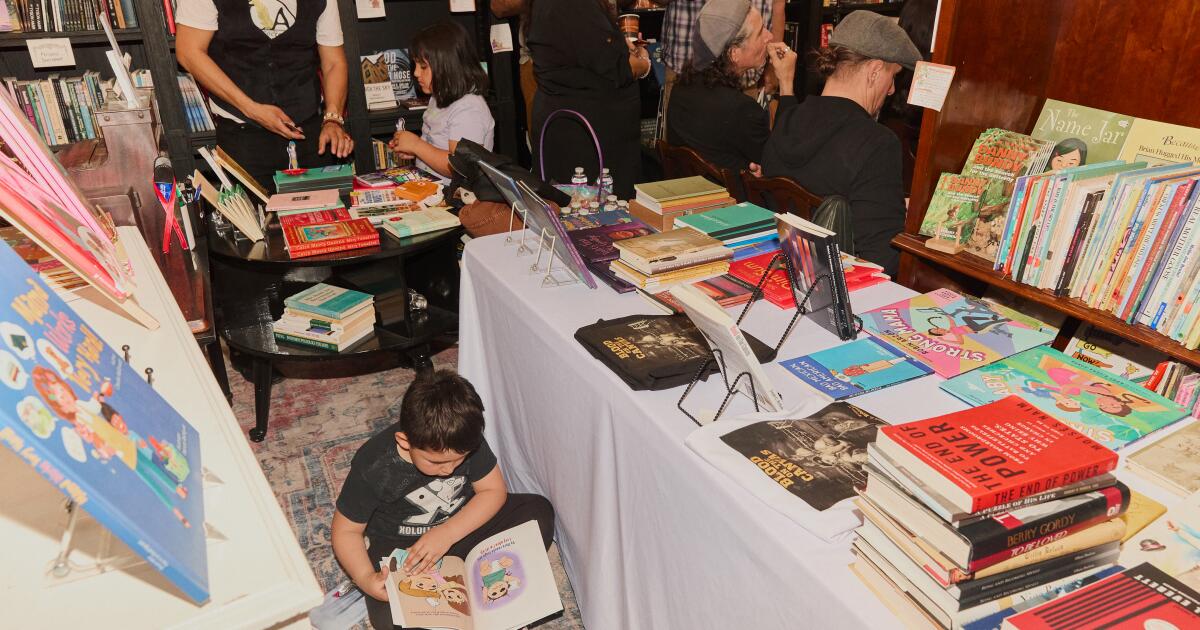
Donato Martinez reads his poetry at the Libros Lincoln Heights bookshop.
On a Saturday evening in late April, the door of the Libros Lincoln Heights is propped open. Inside, 18 local poets pack the narrow single-room bookstore, waiting for a chance to read a poem or two at this month’s open mic in front of an enthusiastic audience.
Donato Martinez, an English professor at Santa Ana College, is the third poet to take the podium. He reads from a stack of loose papers, his hands moving in time with the stanzas he spits like rap bars.
“All street vendors are allowed. / taco stands that never get shut down / Free zone any time / Patrolled by our own. That means Elotes. Churros. Bacon wrapped hot dogs / Fruit cocktails anytime,” Martinez recites from his new poem, titled “If I Was God I Would Visit the Hood.”
The audience snaps and hums, layering their own harmony over the soft whir of the ceiling fan and the cars rushing down North Broadway.
Martinez’s poetry collection “Touch the Sky” can be found on the surrounding shelves, along with collections from three other of the night’s readers. Their presence speaks to the driving ethos behind the Libros: 80% to 90% of the merchandise on the bookstore’s mismatched shelves are written by residents of Lincoln Heights and nearby neighborhoods.
“I don’t just have one little shelf for local authors. The whole place is local authors,” Jesse Marez, the owner of the Libros, said. “It blends in with the neighborhood.”
Marez, an electrical engineer by trade and lifelong book lover, opened the Libros last November, in an effort to consolidate the bookshelves he’d been curating at cafes across the Eastside since late 2021. He estimates that it is the first bookstore in Lincoln Heights in upwards of 70 years.

A sticker for the Libros on the doorway of the shop.
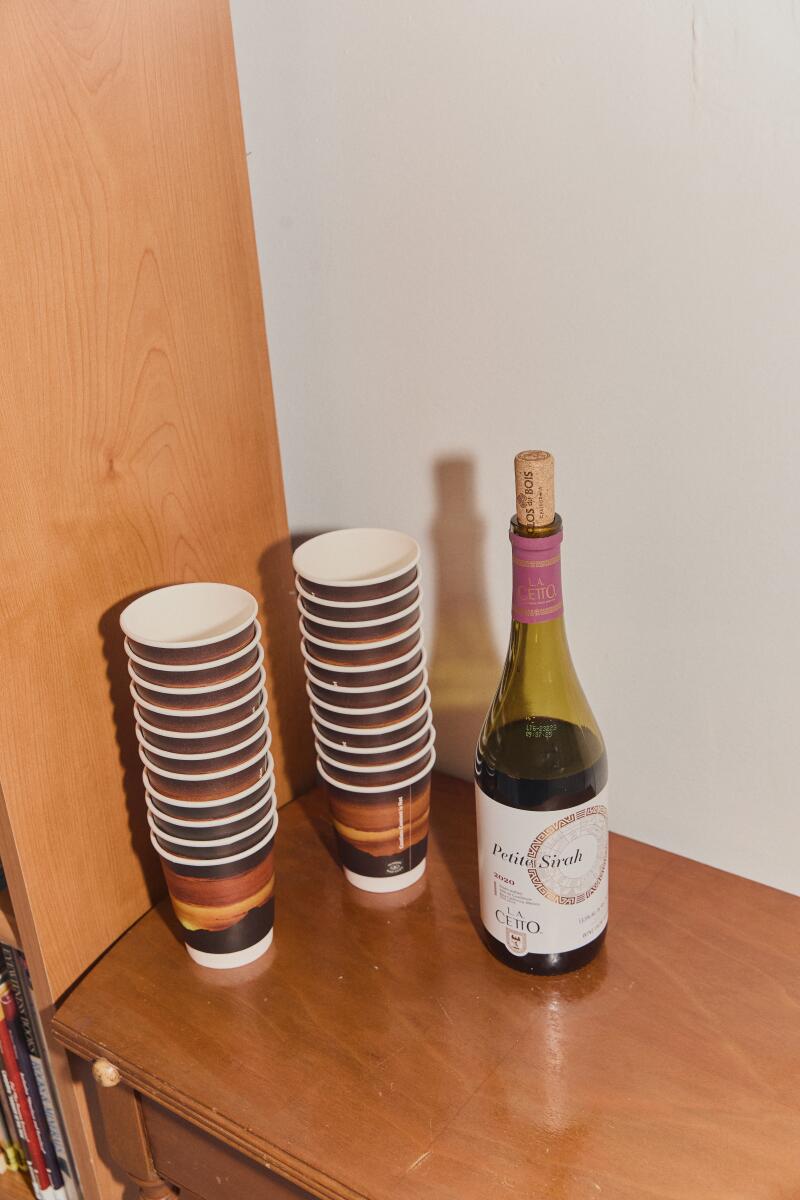
Beverages at the open mic poetry reading.
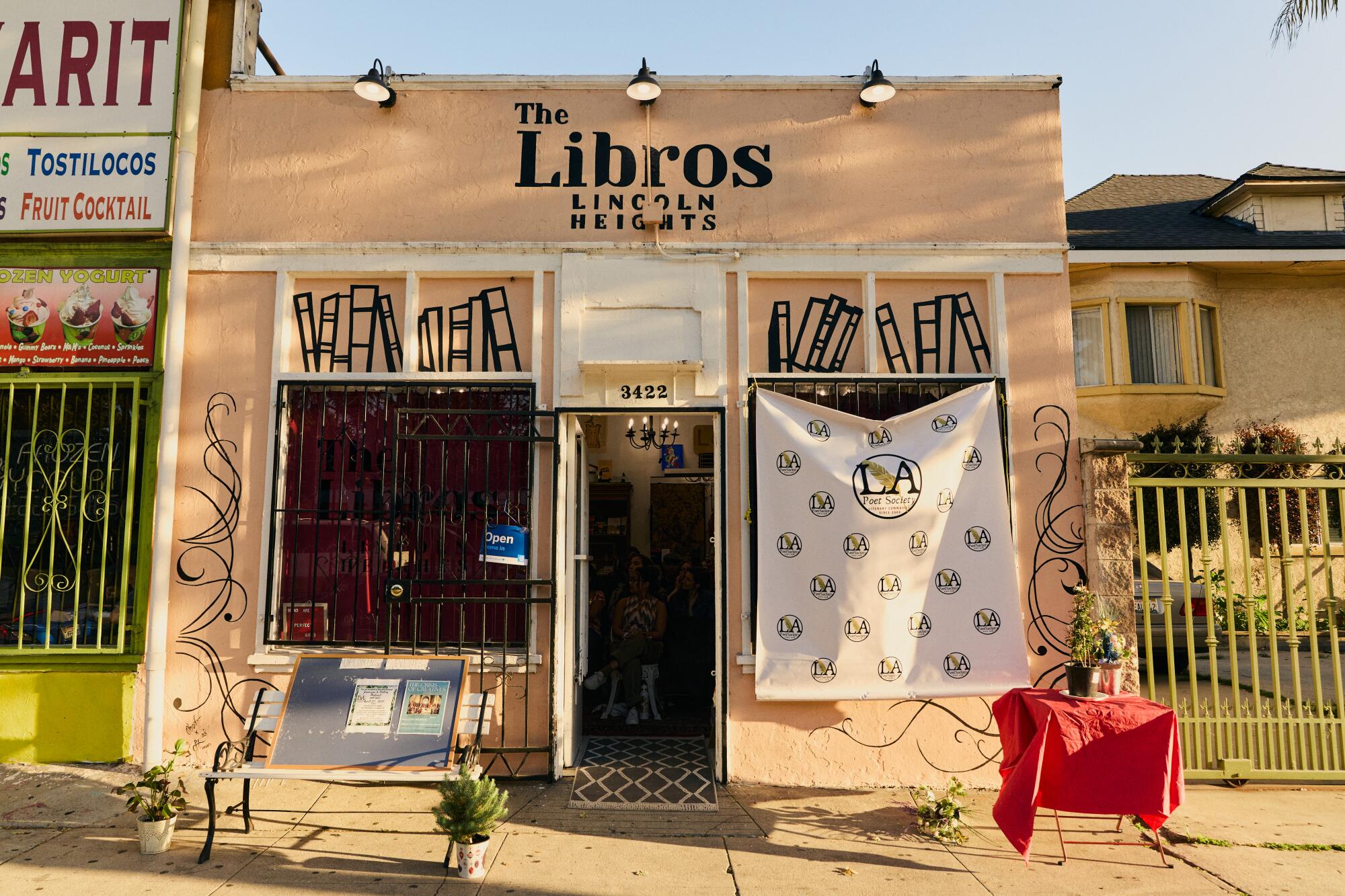
Growing up in Lincoln Heights and neighboring El Sereno, where his family settled after immigrating from Mexico in 1969, Marez experienced this paucity firsthand. Now he’s determined to be at least one place where local authors can share their stories and readers can find a book across a variety of languages and genres.
“We didn’t grow up going to a bookstore or having books, so for me I think it’s valuable for a child,” Marez paused, ducking his head to wipe away tears. “I think it’s important for them to know they can have a book of their own, and it not to be a used book because we’re all used to hand-me-downs. I think in a neighborhood like this, people need to know that they can get a new book, especially at an early age.”
In the months since opening, the Libros has become a neighborhood hub, spotlighting books and authors that can’t always be found on the shelves of other bookstores. Collections of self-published poetry and family histories of Lincoln Heights sit alongside multi-award-winning books by Viet Thanh Nguyen and Kelly Lytle Hernández (also L.A. residents). On a table in the center of the room are copies of “Violet’s First Big Goodbye,” a picture book written by the bookstore’s youngest author, 8-year-old Luna Yanez-Cuestas.
Yanez-Cuestas, who lives in Burbank, wrote and self-published the book with her mother, Adriana Cuestas, to share the grief she felt after saying goodbye to her old neighborhood.
“It’s about saying goodbye to what you really love,” Yanez-Cuestas said.
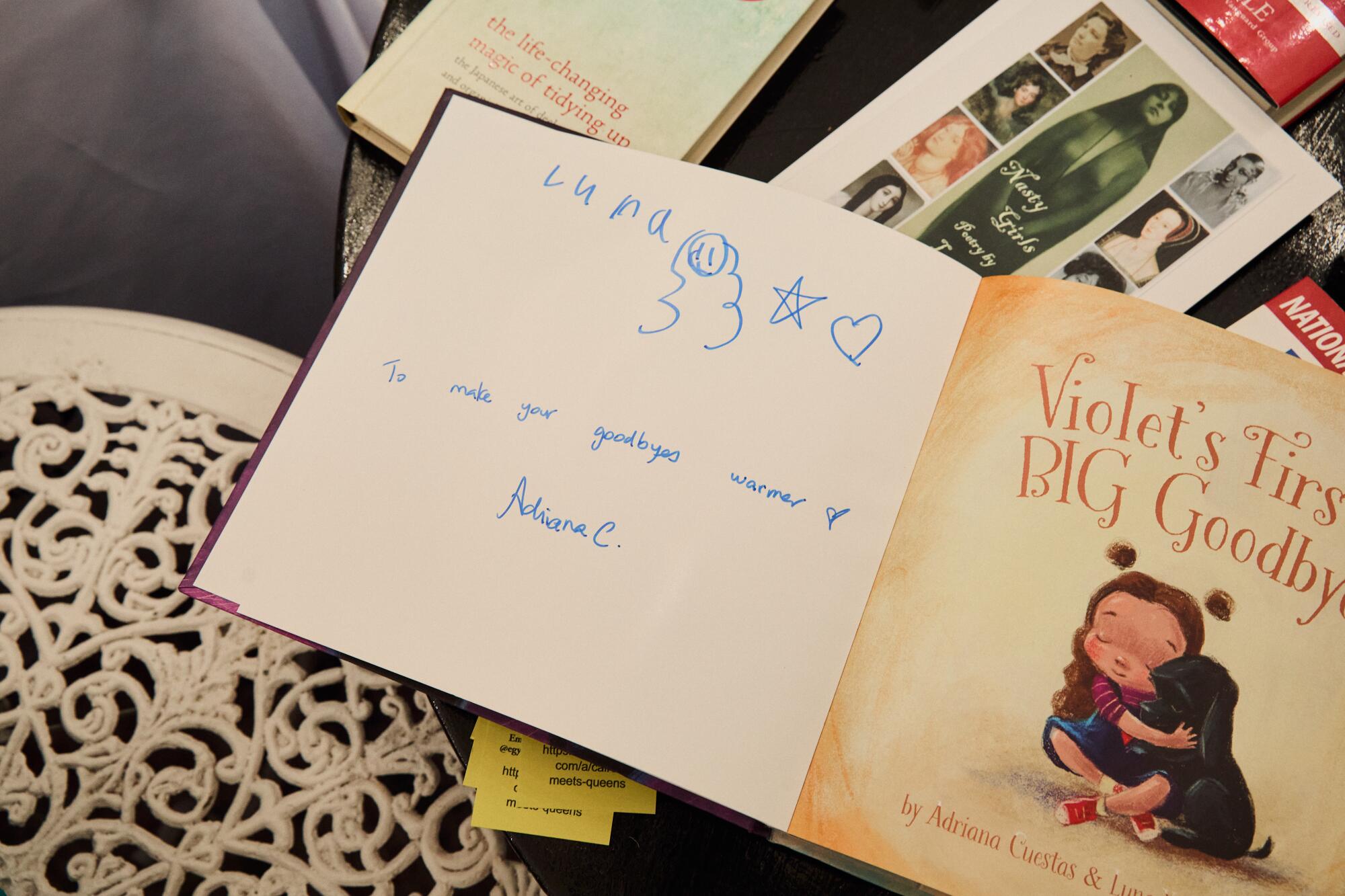
A signed copy of “Violet’s First Big Goodbye” by Luna Yanez-Cuestas lies on a table at the Libros bookshop.
Customers come to the store for this wide selection of books, many of which have been signed by their authors. Marez said most of the books sell quickly because they are local.
Readers aren’t the only ones who frequent the store. Authors regularly stop by with books tucked under their arms, shyly asking whether Marez will sell their memoir or poetry collection. His answer is always an enthusiastic yes, even as shelf space becomes increasingly limited.
Marez has a knack for finding local writers, too. He met Lluvia Arras, L.A.-based author of “A Kids Book About Blended Families,” when their sons were playing soccer together. A few months later, he connected with Joseph Robledo at an exhibit on the Olympic Auditorium at La Plaza de Cultura y Artes.
Robledo is the author of “Blood on the Canvas,” a book commemorating his father, local boxing legend Canto ‘TNT’ Robledo. The son of Mexican immigrants, the elder Robledo became an amateur boxer at 15, turned pro at 16 and won the Pacific Coast Bantamweight Championship at 19. He was on his way to the world championship when a series of injuries left him permanently blind.
“Blood on the Canvas,” guides readers through backyard gyms in South Pasadena to the World Boxing Hall of Fame to tell the story of his father’s transformation from would-be champion to inspirational trainer who touched the lives of hundreds.
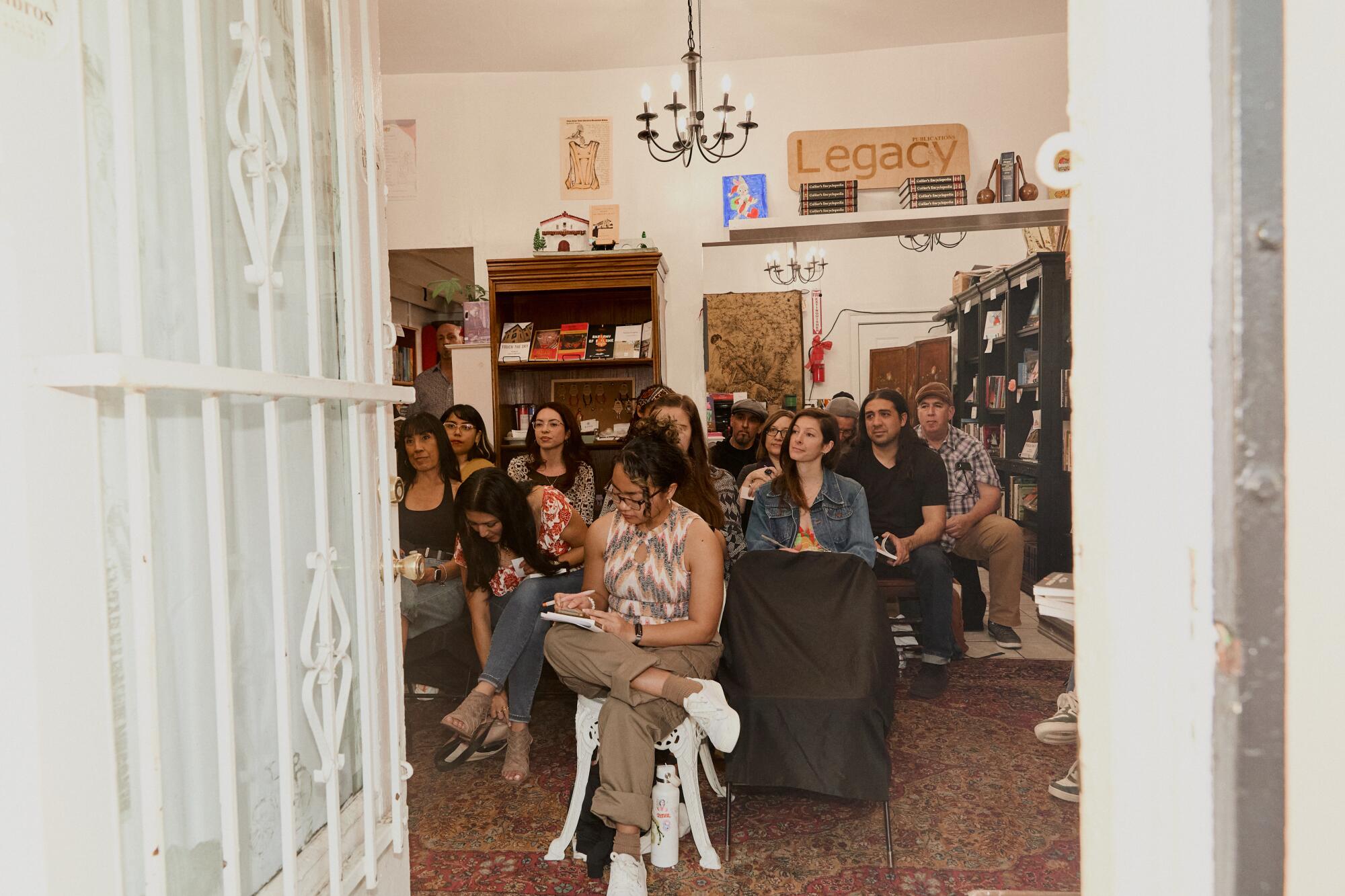
Attendees write poems during a poetry reading and open mic night at the Libros bookshop.
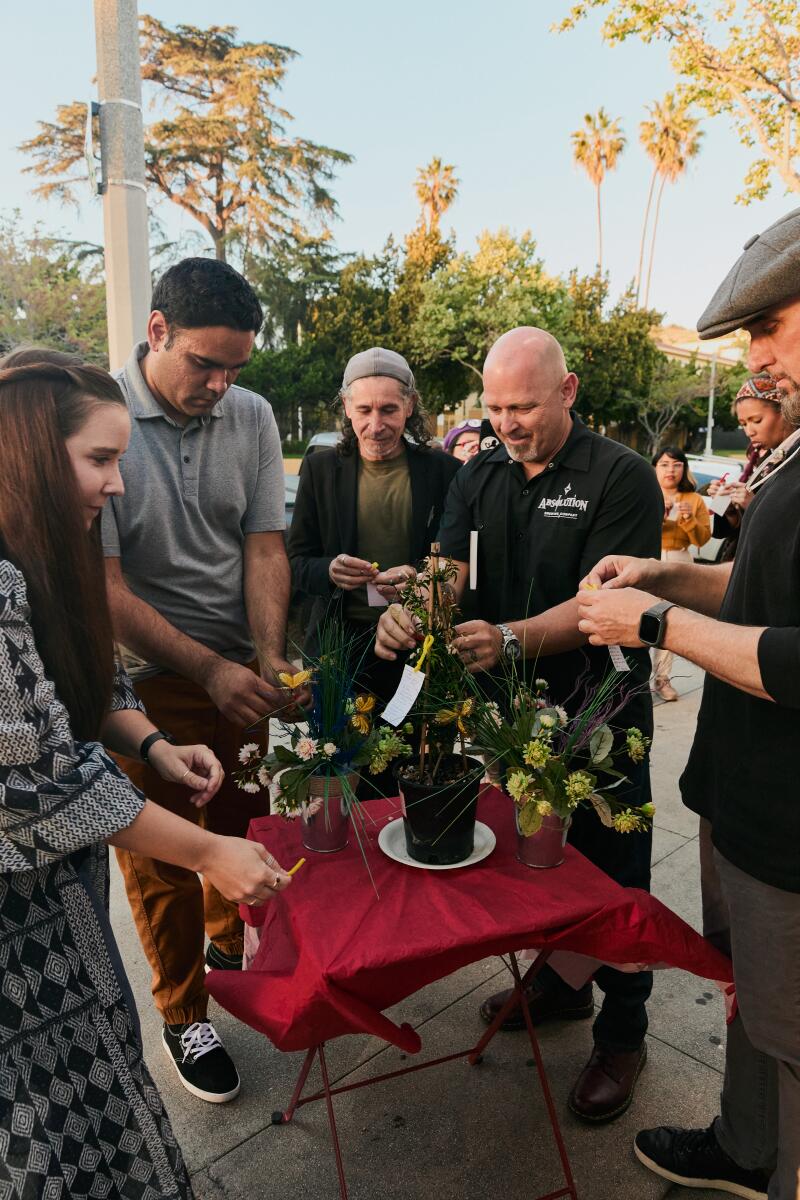

Attendees place their poems on plants outside the Libros bookshop.
Meeting authors like Robledo and Arras has drawn Marez into L.A.’s literary world and taught him tricks of a trade that is often opaque to outsiders.
Behind each book on the store’s shelves is a journey scattered with roadblocks. It’s challenging to break into the mainstream publishing world and, according to a new survey, the industry remains overwhelmingly white.
“I was obsessed with self-publishing because I thought based on how I hear things go for authors in our society, it just didn’t seem fair to give such a big part of your work to another person,” said Cuestas.
For these reasons, authors like Cuestas turn to independent or self-publishing to get their books out into the world. The latter, which has recently become increasingly popular, gives authors creative control and the potential to earn a greater share of the profits, said Brenda Vaca, an author based in Whittier who created her own publishing house to publish her poetry collection titled “Riot of Roses.”
But that creative control comes at the cost of donning all the hats: writer, publisher, distributor and marketer. Stewart J. Zully, who self-published a memoir about the 40 years he spent vending in Yankee Stadium, says he’s spent a large part of his writing career hustling alone and hoping for a break.
“The creativity and the work [to get] it done is one side of the brain and then the business side is completely different,” Zully said.
At the Libros, Marez is trying to lift a few of these hats off the authors’ heads by launching his own publishing company, Legacy Publications.
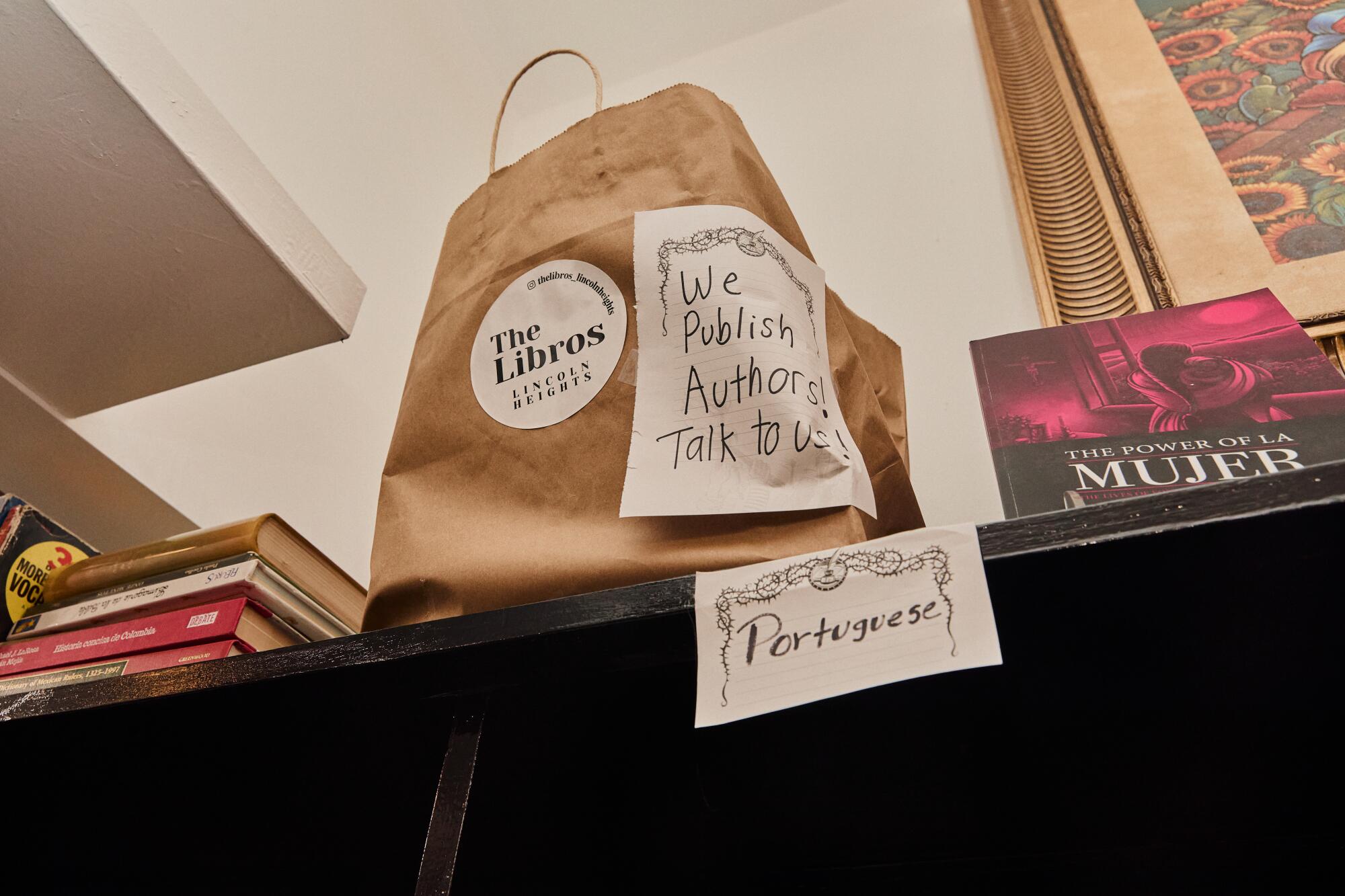
A paper bag with a sign that reads “We publish authors, talk to us” sits atop a shelf at the Libros bookshop.
“What we’re trying to do is help these authors with the distribution and the printing and the publishing,” he said. “Because they’re more worried about how to make a dollar or how to do the distribution, where they should be worried about their second book.”
Like the bookstore, Legacy Publications is deeply rooted in Marez’s pride for the Eastside neighborhoods he grew up in.
“I want to feature people that have actually made our community,” Marez said. “We want to talk about people who have left a legacy in our neighborhoods.’”
In launching this new branch of the business, Marez aims to highlight local voices, help authors make a profit and ensure the books themselves are made with high-quality materials. He prioritizes working with local printers such as Litho Press and Paperleaf Press and plans to release at least three books by the new year.
In his dual roles, Marez is filling Lincoln Heights with books that take readers to distant countries and eras, opening up new worlds. Alongside them, are stories that bring readers home with untold histories of the neighborhoods that have raised them and their families. The authors themselves find solace in knowing that, at least at the Libros, their books will be read and shared.
“Our books, they don’t appear at Barnes & Noble,” Martinez said, referencing how stories by authors of color have largely been kept out of mainstream publishing, and thus bookstores, for generations. “I wish they did and I think our stories belong there. If they’re not at Barnes & Noble, we need these independent bookstores to house our books. We support Libros and then Libros provides a safe space for the writers and poets. I think that right there is a relationship.”
Lifestyle
What did the internet call 'satanic'? Find out in the news quiz

From left: Harrison Butker, a slug, JoJo Siwa
Jason Hanna/Getty Images; Vicky Barlow/@thehidephotography; Jamie McCarthy/Getty Images
hide caption
toggle caption
Jason Hanna/Getty Images; Vicky Barlow/@thehidephotography; Jamie McCarthy/Getty Images

From left: Harrison Butker, a slug, JoJo Siwa
Jason Hanna/Getty Images; Vicky Barlow/@thehidephotography; Jamie McCarthy/Getty Images
Sunday, May 19, marks the one-year anniversary of the NPR news quiz, which opened with Victor Wembanyama and ended with a rainbow slug. Since then, the news has gifted us such fodder as ChatGPT, George Santos, British royals and Barbie. We learned that Jack Smith had a mullet; that one of the Barbies, unlike J. Robert Oppenheimer, has a Nobel Prize in Physics; and that a spotless baby giraffe is kind of creepy.
So, were you paying attention — all year? We hope so.
-

 News1 week ago
News1 week agoSkeletal remains found almost 40 years ago identified as woman who disappeared in 1968
-

 World1 week ago
World1 week agoIndia Lok Sabha election 2024 Phase 4: Who votes and what’s at stake?
-

 Politics1 week ago
Politics1 week agoTales from the trail: The blue states Trump eyes to turn red in November
-

 Movie Reviews1 week ago
Movie Reviews1 week ago“Kingdom of the Planet of the Apes”: Disney's New Kingdom is Far From Magical (Movie Review)
-

 World1 week ago
World1 week agoBorrell: Spain, Ireland and others could recognise Palestine on 21 May
-

 World1 week ago
World1 week agoUkraine’s military chief admits ‘difficult situation’ in Kharkiv region
-

 World1 week ago
World1 week agoCatalans vote in crucial regional election for the separatist movement
-

 Politics1 week ago
Politics1 week agoNorth Dakota gov, former presidential candidate Doug Burgum front and center at Trump New Jersey rally














